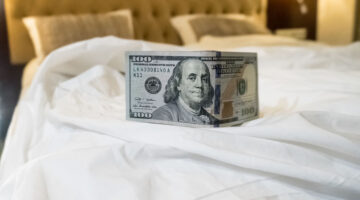Study: Female Strippers Earn More Tips When They’re Ovulating
February 20, 2015 by Justin Lehmiller
Scientists have accumulated a substantial body of research revealing that women’s mating preferences and behaviors appear to change in various ways when they are ovulating. For instance, during ovulation, women fantasize about sex more often, they are more likely to wear red or pink clothing, and they are more flirty with “bad boys.” The theory uniting all of these effects argues that women have evolved to behave in ways that increase their odds of reproductive success when they are at peak fertility.
One of the most well-known and frequently cited pieces of evidence supporting this idea is a titillating study (pun intended) of professional female lap dancers in which scientists examined the amount of money these women made in tips during different phases of the menstrual cycle [1]. Eighteen dancers participated in the study and recorded information about their work shifts and earnings over the course of a 60-day online study.
The results revealed that naturally cycling women (i.e., women who were not taking any type of hormonal contraceptives) experienced an increase in tips when they were ovulating compared to other phases of their cycle. In contrast, women who were taking hormonal contraceptives (which prevented ovulation from occurring) did not show a similar peak in their earnings at any time of the month. The difference between these two groups of women translated to real money too. In fact, naturally cycling women pulled in an average of about $354 per 5-hour shift while ovulating, compared to $200 per 5-hour shift for women who were taking oral contraception.
How do we account for this effect? Did ovulating lap dancers change their behaviors in ways that made them appear more desirable and tip-worthy to male customers? Alternatively, were male customers able to pick up on when the dancers were ovulating, thereby increasing their willingness to tip? We cannot say for sure, but both explanations are plausible. For instance, other research has found that ovulating women are more likely to “dress to impress” [2]. So, perhaps ovulating dancers simply chose more enticing outfits. In addition, research has found that men experience a bigger increase in testosterone levels (a hormone related to the initiation of sexual behavior) when they sniff shirts worn by ovulating women compared to shirts worn by non-ovulating women [3]. This suggests that men may be able to subconsciously detect female ovulation through their noses. Together, these findings highlight the possibility that the amount of money men tip an exotic dancer may not only depend upon how she looks, but also how she smells.
Although this is a small study that does not pinpoint the mechanism by which the effect occurred, it is consistent with the broader ovulatory shifts literature and the general idea that women’s bodies and behaviors may change in subtle ways when they are most fertile.
Want to learn more about Sex and Psychology? Click here for previous articles or follow the blog on Facebook (facebook.com/psychologyofsex), Twitter (@JustinLehmiller), or Reddit (reddit.com/r/psychologyofsex) to receive updates.
[1] Miller, G., Tybur, J. M., & Jordan, B. D. (2007). Ovulatory cycle effects on tip earnings by lap dancers: Economic evidence for human estrus? Evolution and Human Behavior, 28, 375-381.
[2] Haselton, M. G., Mortezaie, M., Pillsworth, E. G., Bleske-Rechek, A., & Frederick, D. A. (2007) Ovulatory shifts in human female ornamentation: Near ovulation, women dress to impress. Hormones and Behavior, 51, 40-45.
[3] Miller, S. L., & Maner, J. K. (2010). Scent of a woman: Men’s testosterone responses to olfactory ovulation cues. Psychological Science, 21, 276-283.
Image Source: 123RF

Dr. Justin Lehmiller
Founder & Owner of Sex and PsychologyDr. Justin Lehmiller is a social psychologist and Research Fellow at The Kinsey Institute. He runs the Sex and Psychology blog and podcast and is author of the popular book Tell Me What You Want. Dr. Lehmiller is an award-winning educator, and a prolific researcher who has published more than 50 academic works.
Read full bio >


